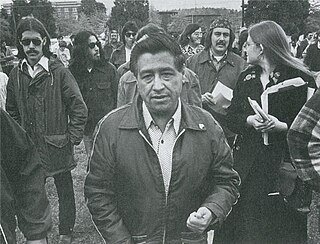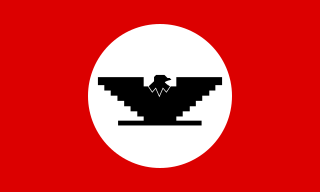Related Research Articles

Chicanismo emerged as the cultural consciousness behind the Chicano Movement. The central aspect of Chicanismo is the identification of Chicanos with their Indigenous American roots to create an affinity with the notion that they are native to the land rather than immigrants. Chicanismo brought a new sense of nationalism for Chicanos that extended the notion of family to all Chicano people. Barrios, or working-class neighborhoods, became the cultural hubs for the people. It created a symbolic connection to the ancestral ties of Mesoamerica and the Nahuatl language through the situating of Aztlán, the ancestral home of the Aztecs, in the southwestern United States. Chicanismo also rejected Americanization and assimilation as a form of cultural destruction of the Chicano people, fostering notions of Brown Pride. Xicanisma has been referred to as an extension of Chicanismo.

Norma Elia Cantú is a Chicana postmodernist writer and the Murchison Professor in the Humanities at Trinity University in San Antonio, Texas.

The Chicano Movement, also referred to as El Movimiento, was a social and political movement in the United States that worked to embrace a Chicano/a identity and worldview that combated structural racism, encouraged cultural revitalization, and achieved community empowerment by rejecting assimilation. Chicanos also expressed solidarity and defined their culture through the development of Chicano art during El Movimiento, and stood firm in preserving their religion.

Chicana feminism is a sociopolitical movement, theory, and praxis that scrutinizes the historical, cultural, spiritual, educational, and economic intersections impacting Chicanas and the Chicana/o community in the United States. Chicana feminism empowers women to challenge institutionalized social norms and regards anyone a feminist who fights for the end of women's oppression in the community.

Yolanda Margarita López was an American painter, printmaker, educator, and film producer. She was known for her Chicana feminist works focusing on the experiences of Mexican-American women, often challenging the ethnic stereotypes associated with them. Lopez was recognized for her series of paintings which re-imagined the image of the Virgen de Guadalupe. Her work is held in several public collections including the Smithsonian American Art Museum, the San Francisco Museum of Modern Art, and the Los Angeles County Museum of Art.
Ester Hernández is a California Bay Area Chicana visual artist recognized for her prints and pastels focusing on farm worker rights, cultural, political, and Chicana feminist issues. Hernández' was an activist in the Chicano Arts Movement in the 1960's and also made art pieces that focus on issues of social justice, civil rights, women's rights, and the Farm Worker Movement.

Chicano studies, also known as Chicano/a studies, Chican@ studies, or Xicano studies originates from the Chicano Movement of the late 1960s and 1970s, and is the study of the Chicano and Latino experience. Chicano studies draws upon a variety of fields, including history, sociology, the arts, and Chicano literature. The area of studies additionally emphasizes the importance of Chicano educational materials taught by Chicano educators for Chicano students.

Lorna Dee Cervantes is an American poet and activist, who is considered one of the greatest figures in Chicano poetry. She has been described by Alurista as "probably the best Chicana poet active today."

The Chicano Art Movement represents groundbreaking movements by Mexican-American artists to establish a unique artistic identity in the United States. Much of the art and the artists creating Chicano Art were heavily influenced by Chicano Movement which began in the 1960s.
Anna Nieto-Gomez is a scholar, journalist, and author who was a central part of the early Chicana movement. She founded the feminist journal, Encuentro Femenil, in which she and other Chicana writers addressed issues affecting the Latina community, such as childcare, reproductive rights, and the feminization of poverty.
Guillermo Acevedo (1920–1988) was a Peruvian-born artist and master draftsman, most famous in the United States for his striking portrayal of Native Americans of the Southwest, and for his ability to capture and help preserve the disappearing architectural styles of old neighborhoods throughout the U.S. and abroad. Known to be an artist-observer with great sensitivity, Acevedo is recognized as a master at recording the human condition.
Yreina Cervantez is an American artist and Chicana activist who is known for her multimedia painting, murals, and printmaking. She has exhibited nationally and internationally, and her work is in the permanent collections of the Smithsonian American Art Museum, The Mexican Museum, the Los Angeles County Museum, and the Los Angeles Museum of Contemporary Art.
Patricia Rodriguez is a prominent Chicana artist and educator. Rodriguez grew up in Marfa, Texas and moved to San Francisco to later pursue an art degree at Merritt College and this is where she learned about the Mexican American Liberation Art Front (MALA-F) and the Chicano Movement. In 1970, Patricia received a scholarship to the San Francisco Art Institute and this is where she met Graciela Carrillo. Together, they created and founded the Mujeres Muralistas, the first Chicana women's mural collective in San Francisco.
Patricia Zavella is an anthropologist and professor at the University of California, Santa Cruz in the Latin American and Latino Studies department. She has spent a career advancing Latina and Chicana feminism through her scholarship, teaching, and activism. She was president of the Association of Latina and Latino Anthropologists and has served on the executive board of the American Anthropological Association. In 2016, Zavella received the American Anthropological Association's award from the Committee on Gender Equity in Anthropology to recognize her career studying gender discrimination. The awards committee said Zavella's career accomplishments advancing the status of women, and especially Latina and Chicana women have been exceptional. She has made critical contributions to understanding how gender, race, nation, and class intersect in specific contexts through her scholarship, teaching, advocacy, and mentorship. Zavella's research focuses on migration, gender and health in Latina/o communities, Latino families in transition, feminist studies, and ethnographic research methods. She has worked on many collaborative projects, including an ongoing partnership with Xóchitl Castañeda where she wrote four articles some were in English and others in Spanish. The Society for the Anthropology of North America awarded Zavella the Distinguished Career Achievement in the Critical Study of North America Award in the year 2010. She has published many books including, most recently, I'm Neither Here Nor There, Mexicans' Quotidian Struggles with Migration and Poverty, which focuses on working class Mexican Americans struggle for agency and identity in Santa Cruz County.
Dorinda Moreno is an American Chicana activist, feminist and writer.

Chicana art emerged as part of the Chicano Movement in the 1960s. It used art to express political and social resistance through different art mediums. Chicana artists explore and interrogate traditional Mexican-American values and embody feminist themes through different mediums such as murals, painting, and photography. The momentum created from the Chicano Movement spurred a Chicano Renaissance among Chicanas and Chicanos. Artists voiced their concerns about oppression and empowerment in all areas of race, gender, class, and sexuality. Chicana feminist artists and Anglo-feminist took a different approach in the way they collaborated and made their work during the 1970s. Chicana feminist artists utilized artistic collaborations and collectives that included men, while Anglo-feminist artists generally utilized women-only participants. Art has been used as a cultural reclamation process for Chicana and Chicano artists allowing them to be proud of their roots by combining art styles to illustrate their multi-cultured lives.
Lorraine Garcia-Nakata is an American artist who works with various mediums including pastel, charcoal, ceramics, printmaking, installation, sculpture, and paint. Her work surrounds themes of the daily life, portraiture, and realism and is known for her large scale artworks. She is a member of the Royal Chicano Air Force (RCAF) artist collective since 1974.
Irma Patricia Aguayo, also known as Patricia Aguayo, is a Chicano Park muralist and longtime activist. She was born and raised in San Diego, California. Both of her parents are from Mexico and she grew up in a Mexican culture household but was told by her parents that in order to succeed in America to act American outside her house. It was in middle school after meeting with her counselor, Ms. Barrios, where she first heard someone of Mexican descent call themselves Chicana that Aguayo realized that she also identified as Chicana. After researching Chicana artists, she realized that there weren't a lot of artists. So she decided that she would create her own artwork.
Angélica Becerra is an activist visual artist who primarily works in watercolor and digital media.
Gracia Molina Enriquez de Pick was a Mexican-American professor and activist.
References
- 1 2 3 4 Guevarra, Rudy P. Jr. (Winter–Spring 2009), "Rita Sanchez: An Oral Interview" (PDF), The Journal of San Diego History, 55 (1): 47–52.
- ↑ Sanchez, Rita (2005), "The Five Sanchez Brothers in World War II", in Rivas-Rodriguez, Maggie (ed.), Mexican Americans & World War II, University of Texas Press, pp. 1–40, ISBN 9780292706811 .
- ↑ Guide to the Rita Sanchez Papers, California Digital Library, accessed 2012-05-14.
- 1 2 Chicano Studies, San Diego Mesa College, archived from the original on 8 July 2012, retrieved 10 May 2012.
- 1 2 3 4 Rita Sanchez, Activist, 2011, San Diego County Women's Hall of Fame, retrieved 2012-05-14.
- ↑ "15. What was Rita Sanchez's Acevedo Art Gallery?", Chapter 11: The Chicana and the Arts, San Diego Mexican and Chicano History, San Diego State University, retrieved 2012-05-14.
- ↑ Gonzalez, Blanca (March 11, 2011), "Women's Museum features diverse collection", The San Diego Union-Tribune .